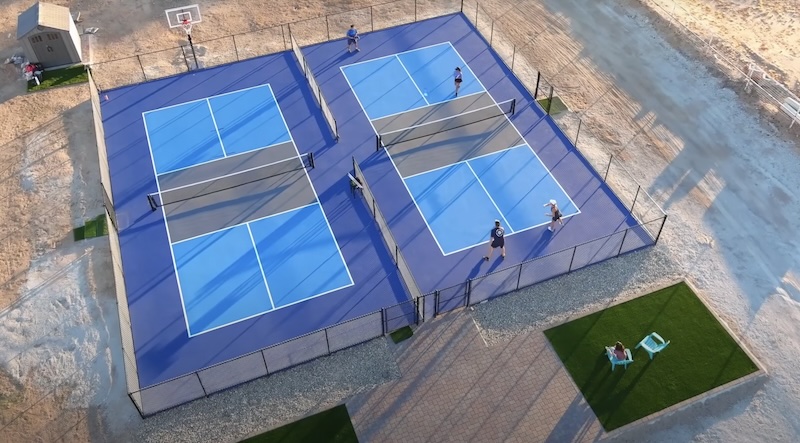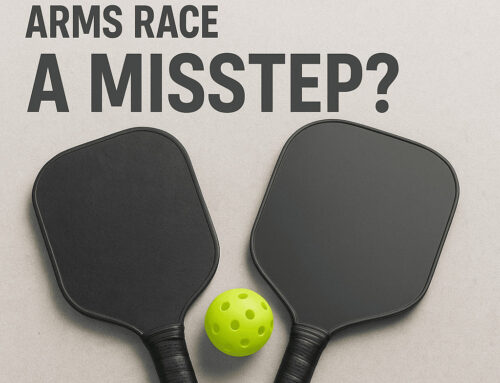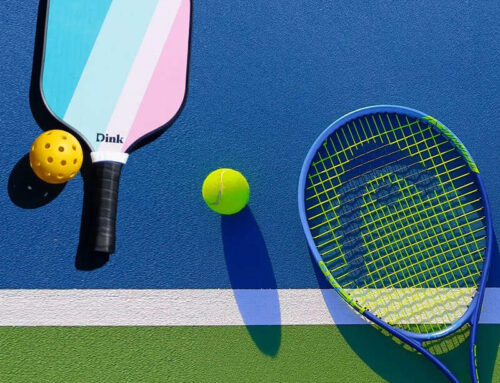As pickleball continues to grow in popularity across the U.S., more and more enthusiasts are moving beyond crowded public courts and choosing to build their own. Today, we’re sharing the story of a passionate pickleball player from Arizona, who recently completed the construction of two professional-grade pickleball courts—from raw land to finished facility in just six months.
This project wasn’t just about building courts; it was about creating a long-lasting, functional, and enjoyable sports space for friends, family, and the community.
Project Overview: Two Full Courts, Designed for Play and Comfort
This Arizona-based player set out with a clear goal: to build two high-quality courts, suitable for serious practice, friendly matches, and small events. Here’s a closer look at the layout and features:
Court Dimensions
Total Area: 64 feet × 60 feet
Each Court: 32 feet × 60 feet (including run-off zones)
Central Walkway: 8 feet wide, paved with brick for accessibility and aesthetics
Surface Material: Post-Tension Concrete
Rather than traditional rebar concrete, the courts use post-tension concrete, a premium option commonly found in tennis and basketball courts. The advantages include:
Superior surface flatness and crack resistance
Improved durability and drainage
Lower long-term maintenance costs
This type of foundation ensures the courts are playable year-round with minimal upkeep.
Color Scheme: Professional and Visually Clear
In-bounds area: Light blue
Out-of-bounds zone: Deep blue (also known as “US Open Blue”)
Kitchen area: Medium gray
The high-contrast color layout improves visibility and reaction time, especially during fast-paced rallies.

Net System: Built to Last
Permanent nets provided by Armor Pickleball, priced at $150 each
Net posts by Edwards, a trusted brand in court equipment ($475 per set, including ground sleeves)
Installed with ground-sleeve anchoring, ensuring stability and professional-level tension
This setup closely mirrors tournament conditions, enhancing gameplay and training quality.
Fencing System: Enclosed for Focused Play
5-foot-high perimeter fencing around the entire court area
Built with gauge-16 residential-grade steel mesh, both durable and attractive
Some fencing materials were repurposed from previous structures, helping to reduce costs
Full enclosure minimizes ball chasing and keeps gameplay flowing
This design not only looks clean but also maximizes player convenience.
Supporting Features: A Space Beyond Just Courts
The project goes beyond basic play areas by incorporating thoughtful extras:
Paved central walkway: 8 feet wide between courts, ideal for foot traffic and sideline viewing
Artificial turf and seating areas: Add relaxation zones for players and guests
Adjustable basketball hoop: Multi-purpose functionality for all ages
Lighting system (planned): LED fixtures to support evening play
This isn’t just a playing space—it’s a complete recreational environment built for enjoyment.
Cost Breakdown: Where the Budget Went
Here’s a detailed breakdown of the project’s construction costs:
| Item | Estimated Cost (USD) | Notes |
|---|---|---|
| Land purchase & concrete work | $38,000 | Includes post-tension concrete base |
| Fencing system | $12,000 | Includes some reused materials |
| Court surfacing & paint | $5,000 – $7,000 | Includes acrylic surfacing and lines |
| Net + post systems | ~$500 per set | Armor net + Edwards post kit |
| Basketball hoop & installation | $2,800 + $250 | Optional feature |
| Total (excluding landscaping & furniture) | ~$60,000 | Covers two full courts |
Tips & Reflections from the Builder
The Arizona builder also shared some personal takeaways from the project:
Plan layout early, especially spacing between courts and access areas
Choose reliable contractors, especially those with experience in post-tension concrete work
Don’t cut corners on quality materials—good nets, coatings, and foundations make a long-term difference
This project wasn’t just for personal use—it’s a lifestyle investment shared with family, friends, and neighbors
Conclusion: Private Pickleball Courts Are Achievable
Building a pickleball court—or two—is a serious project, but as this case shows, it’s absolutely doable for motivated individuals. With thoughtful design, the right team, and clear goals, a private court can become more than a place to play—it can be a place to gather, grow, and live well.
If you’re considering your own pickleball court, let this Arizona project inspire you.
Have your own build story or questions? Leave a comment—we’d love to hear from you!
The End about Mayvoci
1)Design:Over 100 paddle designs and photography service to assist start-up.
2)Professional:Focus on various of paddles manufacturing for 6 years
3)Quality:Strict quality management system to provide safety and satisfaction for customers
4)Amazon:Flexible comprehensive solution to make sure each Amazon seller is well cared.
5)Excellent Team:Experienced paddle experts & dynamic sales team give you 5-star service





